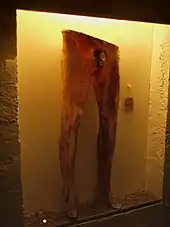Nábrók
Nábrók (calqued as necropants, literally "corpse britches") are a pair of pants made from the skin of a dead human, which are believed in Icelandic witchcraft to be capable of producing an endless supply of money. It is highly unlikely these pants ever existed outside of folklore.[1]

Ritual
The ritual for making necropants is described as follows:[3]
According to the ritual, to create a pair of necropants, the sorcerer must first make a pact with a friend, stating that once the friend has died of natural causes, the sorcerer has permission to skin them from the waist down. Once the friend is dead, the greedy magician must then wait until the friend has been buried, dig up the body, and then skin the lower half of the corpse without creating any holes or tears, thus creating a pair of gruesome skin pants.
Once the “necropants” have been created, the caster must don the purloined pantaloons against his bare skin. Now the ritual requires that the sorcerer steal a coin from a destitute widow,(a widow stricken with infirmity due to old age, physical disability, chronic ailment, mental imbalance or who has no source of income to support herself and her dependent children, if any;) and place it in the empty scrotum of the pants along with the magical Icelandic stave (symbol), Nábrókarstafur, written on a scrap of parchment. And that’s it!
The pants soon become indistinguishable from the wearer’s body, and so long as the original coin was not removed, the scrotum should continue to miraculously fill with coins for the rest of time.
References
- McMahon, Sara (24 December 2014). "The macabre necropants, made from dead man's skin, on display in Hólmavík". Iceland Magazine.
Whenever someone asks me whether they are real or whether a pair ever existed, I'm forced to tell the truth: Necropants have only ever existed in local folk legends.
- "Galdrastafir – Galdrasýning á Ströndum" (in Icelandic). Retrieved 2023-07-27.
- "Necropants and Other Tales of 17th-Century Icelandic Sorcery". Atlas Obscura. 2017-09-18. Retrieved 2023-07-27.
